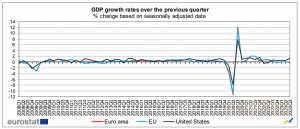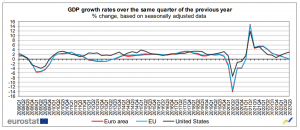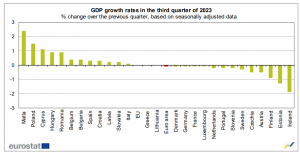December 11, 2023
GDP growth in the euro area and the EU
According to the statistical office of the European Union (Eurostat), the seasonally adjusted GDP fell by 0.1% in the euro area and remained stable in the EU during the third quarter of 2023, relative to the previous quarter. It was also noted that in the second quarter of 2023, GDP had risen by 0.1% in the euro area and the EU.
In comparison to the third quarter of 2022, seasonally adjusted GDP remained stable in the euro area and the EU during the third quarter of 2023. This was after increases of 0.6% and 0.5% were respectively realized in the euro area and EU during the second quarter of 2023.
For the United States, GDP grew by 1.3% in the third quarter of 2023 relative to the previous quarter. This was after increasing by 0.5% in the second quarter of 2023. The GDP grew by 3.0% relative to the same quarter last year, having climbed by 2.4% in the prior quarter.


GDP growth by Member State
Among the Member States, Eurostat noted that the largest increases in GDP relative to the previous quarter were observed in Malta (+2.4%), Poland (+1.5%) and Cyprus (+1.1%). The highest declines were observed in Ireland (-1.9%), Estonia (-1.3%) and Finland (-0.9%).

GDP components and contributions to growth
In the third quarter of 2023, household final consumption expenditure climbed by 0.3% in the euro area and by 0.4% in the EU (following 0.0% and +0.2%, respectively in Q2 2023). In both zones, government final consumption expenditure climbed by 0.3% (following +0.2% in both zones in Q2 2023). Gross fixed capital formation in the euro area remained stable, while it grew by 0.2% in the EU (following -0.1% and +0.1%, respectively in Q2 2023). Exports fell 1.1% in the euro area and 1.0% in the EU (after falling 1.1% in the eurozone and 1.0% in the EU in Q2 2023). Imports fell by 1.2% in the eurozone and 1.4% in the EU (after 0.0% and -0.1%, respectively in Q2 2023).
Household final consumption expenditure had positive contributions to GDP growth in both the euro area and the EU (+0.2 percentage points – pp). Both zones’ contributions from government final expenditure were positive (+0.1 pp). Gross fixed capital formation contributions were minimal for the eurozone and the EU. External balance contributions were insignificant for the euro area but positive for the EU (+0.2 pp). The contributions from changes in inventories were negative for both zones (-0.3 pp for the euro area and -0.5 pp for the EU).
Disclaimer:
Analyst Certification – The views expressed in this research report accurately reflect the personal views of Mayberry Investments Limited Research Department about those issuer (s) or securities as at the date of this report. Each research analyst (s) also certify that no part of their compensation was, is, or will be, directly or indirectly, related to the specific recommendation (s) or view (s) expressed by that research analyst in this research report.
Company Disclosure – The information contained herein has been obtained from sources believed to be reliable, however, its accuracy and completeness cannot be guaranteed. You are hereby notified that any disclosure, copying, distribution or taking any action in reliance on the contents of this information is strictly prohibited and may be unlawful. Mayberry may affect transactions or have positions in securities mentioned herein. In addition, employees of Mayberry may have positions and effect transactions in the securities mentioned here.
